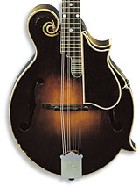
When Gibson’s F-5 was introduced in mid 1922, it was part of the series of Style 5 “Master Models” consisting of the F-5 mandolin, H-5 mandola, K-5 mandocello, and the L-5 guitar. These instruments all featured a special oval-shaped Master Model label visible through the bass-side f hole, and a matching-shape signature label signed and dated by Gibson acoustical engineer Lloyd Loar (visible through the treble-side f hole).
After Loar left the company at the end of 1924, the signature labels were discontinued and the specifications of the instruments were altered. In the opinion of the overwhelming majority of players and collectors, the Loar-signed Master Model instruments are the great pinnacle of perfection in mandolin family instruments such that today they are greatly sought by collectors as well as musicians and command the highest prices of any mandolin family instruments ever manufactured by any maker.
When the F-5 and the other Master Model instruments were introduced, they were highly innovative and featured numerous new design concepts, including a longer neck on the mandolin such that the bridge was placed closer to the center of the soundboard, f holes rather than an oval soundhole, two parallel tone bars on the underside of the top rather than one small crossbar, fingerboard extension elevated over the top rather than glued onto the top so as to free the entire soundboard to vibrate more freely, and carefully graduated tap-tuned tops and backs as well as a tuned air chamber.
All Style 5 Master Models featured well-figured curly maple necks, backs, and sides, spruce tops, ebony fingerboards, “The Gibson” pearl inlay peghead logo, and abalone flower pot peghead inlay (by 1924 some F-5s as well as H-5 mandolas featured fern abalone peghead inlay). The F-5, H-5, and K-5 featured hand-engraved tailpiece covers with a “The Gibson” logo and the metal hardware was silver plated with the exception of gold plating on a few 1924 models. The rich Cremona brown sunburst varnish finish is very distinctive of the Loar models and was not a catalog standard color on any other Gibsons of this time period, although it was available as a custom color option appearing on a few F-4 model mandolins. Many of the 1924 models featured the optional “Virzi tone producer” wood resonator disc mounted from the bracing on the underside of the top.
While the F-5 was without a doubt an extremely innovative instrument, it was not a great commercial success. Gibson records of the period are incomplete, but to the best ability of Gibson historians today, it’s estimated that approximately 250 Loar-signed F-5s were produced, and close to 100 Loar-signed H-5, K-5, and L-5s combined were made. By comparison, Gibson had sold vastly more F-2 and F-4 models. Although it’s sometimes stated that the F-5 probably did not sell well due to being priced higher than the F-4, in all probability, that’s not the case. In 1914, the Gibson price sheet indicates the F-4 listed at $177 (reduced after the F-5 was introduced) whereas when the F-5 was introduced in mid 1922, it was priced at $200 and was raised to $250 in 1923.
F-5 models are extremely scarce, not due to their higher original price, but due to the fact that as innovative as they were, they were introduced too late to capitalize on the mandolin orchestra boom of 1900 through 1921. Dealers who have been in business over the past 40 years may have encountered numerous Gibson mandolins made during from 1905 through 1921, but have likely seen far fewer made from 1922 onward. This is true not only of high-end models such as the F-5, but even lower-grade student A models, as well as the F-2 and F-4 models. This coincides with a drastic drop in popularity of mandolin orchestras which occurred when the Dixieland era emerged featuring brass, piano, and tenor banjo.
When the F-5 was introduced, it was the finest mandolin ever made, but it was in some ways akin to introducing the ultimate buggy whip after the automobile had been invented. Once Dixieland came in and the mandolin orchestra era ended customers simply didn’t care how good a mandolin was. There was virtually no demand. Some instruments, such as the Gibson Explorer and Flying V, were introduced ahead of their time. They were simply too radical and innovative to sell well at first, but later became highly regarded and commercially successful. Others, such as the F-5 were introduced too late to be a commercial success. Gibson mandolin sales from 1922 through 1940 were extremely slow.
It was not until Bill Monroe bought a 1923 Loar F-5 in the mid ’40s, and developed his signature sound with it that demand for F-5s picked up.
Lloyd Loar and the Gibson design team never dreamed that this instrument could be used for anything resembling bluegrass music. The F-5 was designed for classical playing, but it has gone on to achieve its greatest prominence in bluegrass, country, jazz, and other forms of modern music.
Today, Loar-signed F-5s are without doubt the most valuable mandolins ever made by any manufacturer, and are among the most valuable of all Gibson-made instruments, rivaling in price even well-figured 1959 sunburst Les Paul Standards.
Photo courtesy George Gruhn.
This article originally appeared in VG‘s April ’04 issue. All copyrights are by the author and Vintage Guitar magazine. Unauthorized replication or use is strictly prohibited.


